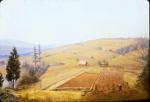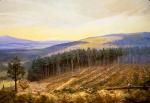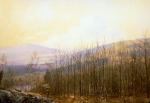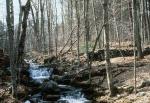You are here
Landscape History of Central New England
Seven of the Harvard Forest dioramas form a historical series that depicts changes in the New England landscape over the past 300 years at one location. The scene was designed to depict all the important transformations of the landscape in the upland area of central Massachusetts since the pre-European-settlement period.
The ecological and historical interpretation of the details and significance of these transformations has changed little since Fisher and his colleagues designed the dioramas in the 1920s and 1930s. Importantly, the concepts presented in the dioramas provide the basis for much current understanding and research ecology, conservation biology, and forest management at the Harvard Forest and beyond.
One of the major lessons that emerges from the dioramas is that in order to understand our forests today we need to become deeply knowledgeable about their particular history. This historical perspective shows us that our forests have always been characterized by change and carry a strong cultural legacy of past human activity. This understanding should inform our predictions of future forest development, as well as our attempts to conserve and manage them.









